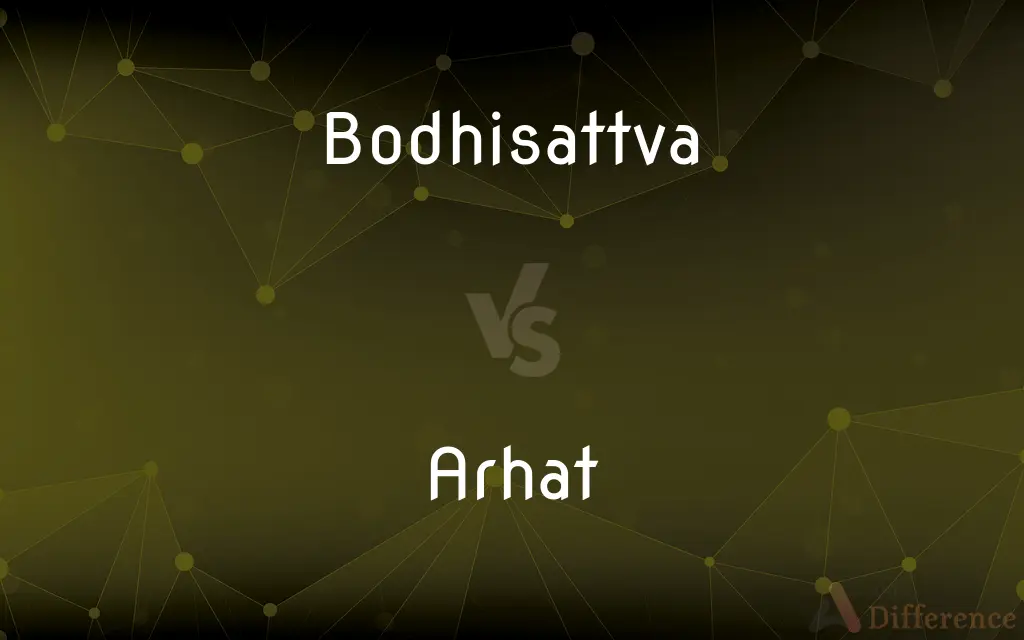Bodhisattva vs. Arhat — What's the Difference?
Edited by Tayyaba Rehman — By Maham Liaqat — Updated on May 1, 2024
Bodhisattvas aspire to attain Buddhahood for the benefit of all beings, emphasizing compassion and altruism, whereas Arhats seek personal enlightenment and nirvana, focusing on self-liberation.

Difference Between Bodhisattva and Arhat
Table of Contents
ADVERTISEMENT
Key Differences
A Bodhisattva is a being who seeks enlightenment not just for themselves but to assist all sentient beings in achieving Buddhahood. This role is central in Mahayana Buddhism, which emphasizes the virtue of altruism. On the other hand, an Arhat, primarily recognized in Theravada Buddhism, seeks personal enlightenment and aims to achieve nirvana, focusing on personal liberation from the cycle of birth and rebirth.
Bodhisattvas undertake the path of a Bodhisattva, which involves practicing the six perfections (paramitas) including generosity, morality, patience, energy, meditation, and wisdom, to cultivate the qualities necessary to help others. Whereas Arhats follow the Noble Eightfold Path more strictly for their own spiritual development, aiming to extinguish all personal desire and attachment.
The concept of a Bodhisattva includes the vow to be reborn, if necessary, to continue helping others until all beings are freed from suffering. Conversely, Arhats, having achieved their ultimate goal, enter nirvana and are no longer reborn, as they have ended the cycles of suffering and rebirth.
Bodhisattvas are often depicted as compassionate and merciful figures, always ready to postpone their own nirvana to assist others. In contrast, Arhats are portrayed as serene and detached, having overcome all worldly desires and emotions.
The motivation driving a Bodhisattva is the altruistic intention (bodhicitta) to attain Buddhahood for the sake of all living beings, which highlights a fundamental difference in their spiritual aspirations compared to Arhats, who seek personal peace and enlightenment.
ADVERTISEMENT
Comparison Chart
Goal
Achieve Buddhahood to help all beings
Achieve personal enlightenment and nirvana
Path
Six Perfections
Noble Eightfold Path
Rebirth
May choose rebirth to continue helping
No rebirth; achieve nirvana
Key Virtue
Compassion and altruism
Detachment and personal liberation
Buddhist Tradition
Prominent in Mahayana
Central in Theravada
Compare with Definitions
Bodhisattva
A being seeking enlightenment for themselves and others.
The tale of the compassionate Bodhisattva saving the drowning child inspires many.
Arhat
Known for having extinguished all personal desires.
An Arhat is detached, having overcome all desires and emotions.
Bodhisattva
A key figure in Mahayana Buddhism.
The temple walls are adorned with paintings of various Bodhisattvas.
Arhat
A person who has reached enlightenment and nirvana.
The Arhat lives in peace, free from worldly suffering.
Bodhisattva
A person on the path to Buddhahood, emphasizing altruism.
His actions reflect those of a Bodhisattva, always helping others selflessly.
Arhat
The ultimate state of an enlightened disciple.
Reaching the state of an Arhat is seen as the culmination of one's spiritual path.
Bodhisattva
One who vows to become a Buddha.
She practices diligently, aspiring to the path of a Bodhisattva.
Arhat
A figure who embodies personal spiritual liberation.
The Arhat’s journey is one of profound self-discovery and liberation.
Bodhisattva
Represents the ideal of ultimate compassion.
The Bodhisattva’s compassion is limitless, extending to all sentient beings.
Arhat
Someone who has attained the goal of Theravada Buddhism.
As an Arhat, he no longer undergoes rebirth.
Bodhisattva
In Buddhism, a bodhisattva ( BOH-dee-SUT-və) is any person who is on the path towards Buddhahood. In the Early Buddhist schools as well as modern Theravada Buddhism, a bodhisattva (Pali: bodhisatta) refers to anyone who has made a resolution to become a Buddha and has also received a confirmation or prediction from a living Buddha that this will be so.In Mahayana Buddhism, a bodhisattva refers to anyone who has generated bodhicitta, a spontaneous wish and compassionate mind to attain Buddhahood for the benefit of all sentient beings.The elaborate concept refers to a sentient being or sattva that develops bodhi or enlightenment — thus possessing the boddhisattva's psyche; described as those who work to develop and exemplify the loving-kindness (metta), compassion (karuṇā), empathetic joy (mudita) and equanimity (upekkha).
Arhat
In Buddhism, an arhat (Sanskrit) or arahant (Pali) is one who has gained insight into the true nature of existence and has achieved nirvana. Mahayana Buddhist traditions have used the term for people far advanced along the path of Enlightenment, but who may not have reached full Buddhahood.The understanding of the concept has changed over the centuries, and varies between different schools of Buddhism and different regions.
Bodhisattva
An enlightened being who, out of compassion, forgoes nirvana in order to save others.
Arhat
One who has attained enlightenment.
Bodhisattva
(Buddhism) A person who has taken specific lay or monastic vows and who is on the road to perfect knowledge; specifically, one who foregoes personal nirvana in order to help others achieve enlightenment.
Arhat
(Buddhism) One who has attained enlightenment; a Buddhist saint.
Bodhisattva
(Buddhism) An enlightened being existing in a form of existence beyond the ordinary forms of physical reality understood and acknowledged by scientific thought, resembling the Western notion of angels, but with a wealth of its own nuances and expectations. These include the compassionate working for enlightenment of all sentient beings.
Arhat
(Jainism) One of the stages of the ascetic's spiritual evolution, when all passions (anger, ego, deception, greed, attachment, hatred and ignorance) are destroyed; arhanta.
Bodhisattva
Buddhist worthy of nirvana who postpones it to help others
Arhat
A Buddhist who has attained nirvana.
Arhat
A Buddhist who has attained nirvana
Common Curiosities
What is the primary difference in the goals of a Bodhisattva and an Arhat?
Bodhisattvas aim for enlightenment to help all beings, whereas Arhats seek personal enlightenment and nirvana.
Which Buddhist tradition emphasizes the role of Bodhisattvas?
The Mahayana tradition emphasizes the role of Bodhisattvas.
What drives a Bodhisattva to postpone their own nirvana?
Bodhisattvas postpone their nirvana out of compassion to assist all beings achieve enlightenment.
What is the ultimate goal of an Arhat in Theravada Buddhism?
The ultimate goal of an Arhat is to achieve personal enlightenment and enter nirvana.
How does the path of a Bodhisattva differ from that of an Arhat?
Bodhisattvas follow the path of six perfections focusing on altruism, while Arhats follow the Noble Eightfold Path for personal liberation.
What are the six perfections practiced by Bodhisattvas?
The six perfections include generosity, morality, patience, energy, meditation, and wisdom.
What does achieving nirvana mean for an Arhat?
Achieving nirvana means that an Arhat has been liberated from all suffering and will no longer be reborn.
Can Arhats choose to be reborn like Bodhisattvas?
No, Arhats achieve nirvana and are not reborn, unlike Bodhisattvas who may choose rebirth to continue assisting others.
Is the concept of Arhat present in Mahayana Buddhism?
While the concept exists, it is not as central as in Theravada Buddhism.
How are Bodhisattvas typically depicted in Buddhist art?
Bodhisattvas are depicted as compassionate and merciful figures.
What distinguishes the Bodhisattva's motivation from the Arhat's?
The Bodhisattva is motivated by altruism for all beings, whereas the Arhat is motivated by personal liberation.
Are Bodhisattvas considered fully enlightened?
No, Bodhisattvas are on the path to Buddhahood but are not yet fully enlightened.
What role does detachment play in the life of an Arhat?
Detachment helps Arhats overcome desires and emotions, leading to personal enlightenment and liberation.
How does the altruism of a Bodhisattva manifest in their actions?
It manifests through acts of generosity, teaching, and direct assistance to others in need.
What is bodhicitta?
Bodhicitta is the compassionate wish to attain Buddhahood for the benefit of all sentient beings, a key concept for Bodhisattvas.
Share Your Discovery

Previous Comparison
Senpai vs. Sensei
Next Comparison
Pattern vs. DesignAuthor Spotlight
Written by
Maham LiaqatEdited by
Tayyaba RehmanTayyaba Rehman is a distinguished writer, currently serving as a primary contributor to askdifference.com. As a researcher in semantics and etymology, Tayyaba's passion for the complexity of languages and their distinctions has found a perfect home on the platform. Tayyaba delves into the intricacies of language, distinguishing between commonly confused words and phrases, thereby providing clarity for readers worldwide.
















































